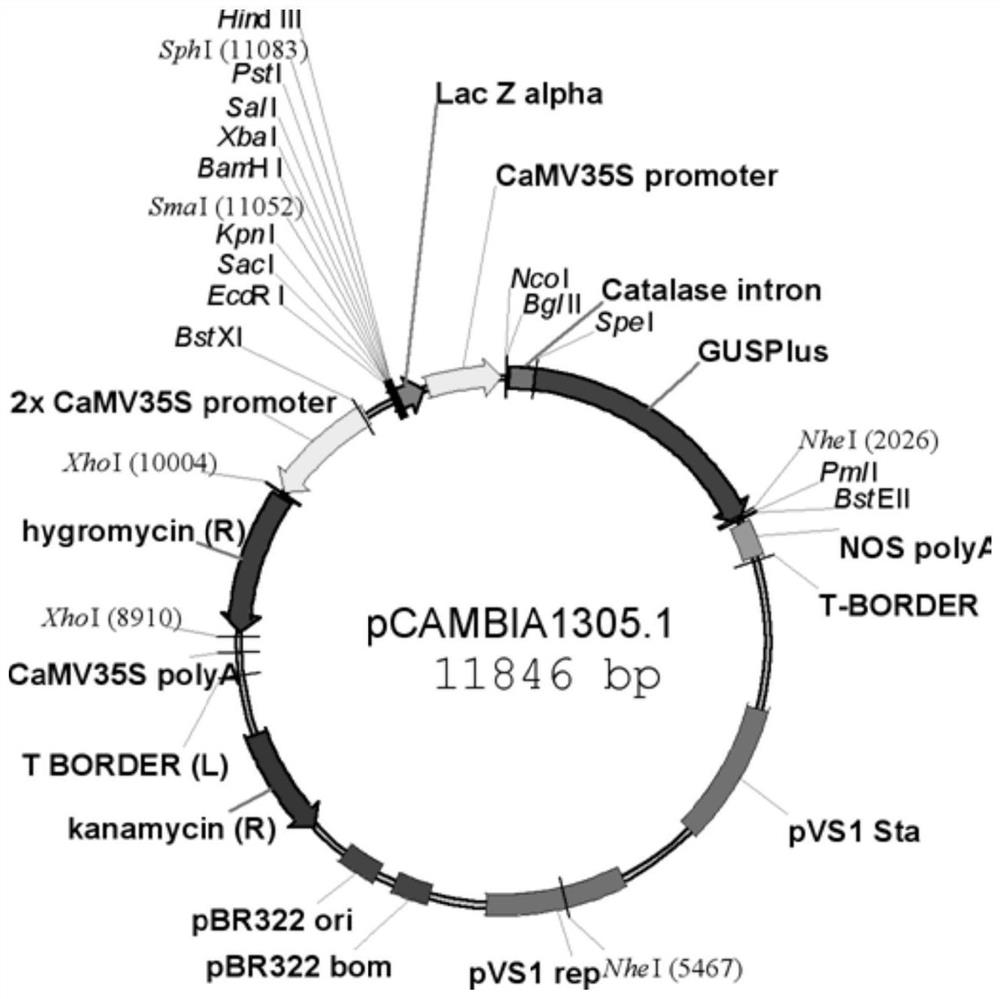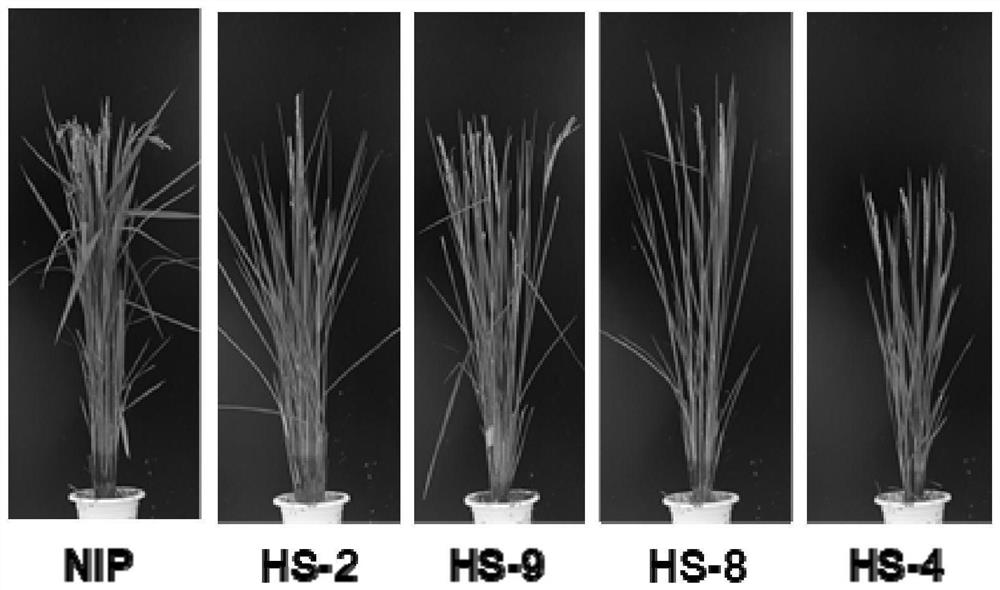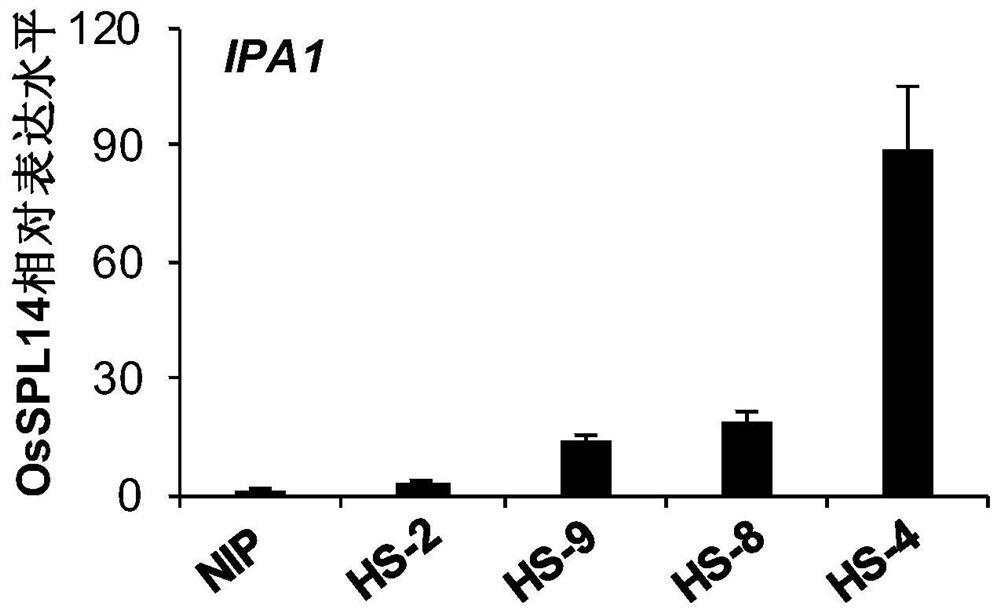poshen1::osspl14 gene expression cassette and its construction method and application
A technology of gene expression cassette and construction method, which is applied in the field of construction and breeding application of pOsHEN1::OsSPL14 gene expression cassette, which can solve problems such as hindering gene application, decreased seed yield, decreased fertility, etc., and achieves broad application and market prospects, Effect of increasing yield and enhancing disease resistance
- Summary
- Abstract
- Description
- Claims
- Application Information
AI Technical Summary
Problems solved by technology
Method used
Image
Examples
Embodiment 1
[0062] Example 1 Constructing the pOsHEN1::OsSPL14 gene expression cassette and constructing a recombinant expression vector containing the pOsHEN1::OsSPL14 gene expression cassette
[0063] S1: Design cloning pOsHEN1-F primer about 2000bp upstream of the transcription start site of rice OsHEN1 gene, design pOsHEN1-R primer at the end of the 5' untranslated region of OsHEN1, use rice Nipponbare DNA as template, and OsHEN1 promoter-specific Primers pOsHEN1-F: tatgaccatgattacgaattcTTATGTGCACTAGAAACTATCTGAGGAC (SEQ ID No. 1) and pOsHen1-R: CAAACGCCCAAAAAAAACAA (SEQ ID No. 2) were used for PCR amplification, and the promoter amplification product of OsHen1 was cloned;
[0064] S2: Design primers for cloning OsSPL14-F based on the transcription start site of OsSPL14, and design primers for cloning OsSPL14-R about 500 bp downstream of the OsSPL14 transcription termination site, using rice Nipponbare DNA as a template, and OsSPL14 gene-specific primer OsSPL14-F: ttgttttttttgggcgtttgTT...
Embodiment 2
[0077] Example 2 Transformation of rice with the recombinant expression vector containing the pOsHen1::OsSPL14 gene expression cassette to obtain the transgenic line HS
[0078] The rice used for transformation is: wild-type rice Nipponbare (NIP).
[0079] The transformation method mediated by Agrobacterium oryzae was used to obtain multiple stable transgenic lines for the experimental research of the present invention. The specific transformation, infection and transgenic rice cultivation methods are as follows:
[0080] 1. Peel the mature rice seeds and select healthy and complete seeds.
[0081] 2. Wash and soak with 70% ethanol for 2-3 minutes, wash two to three times, and then wash with 10% sodium hypochlorite solution for 30 minutes.
[0082] 3. Wash with sterile water three to four times.
[0083] 4. Dry the peeled seeds on sterile filter paper.
[0084] 5. Place the dried seeds on the induction medium, and culture them in the dark for 15-20 days, until a large yellow...
Embodiment 3
[0092] Example 3 Study on Agronomic Traits of Transgenic Lines Without PXO99A Induction
[0093] In this study, the wild-type rice Nipponbare (NIP) was used as a control to study the agronomic traits of the four transgenic lines HS-2, HS-9, HS-8, and Hs-4 obtained in Example 2 without being induced by PXO99A.
[0094] 3.1 Plant background OsSPL14 expression level
[0095] Research method: Fluorescence quantitative PCR
[0096] 3.2 Trizol method to extract total RNA
[0097] Four transgenic lines HS-2, HS-9, HS-8, Hs-4 and NIP control were not induced by PXO99A, and the leaf samples were taken as follows:
[0098] (1) Weigh 0.1 g of fresh leaves, grind them quickly in liquid nitrogen with a mortar, and transfer them to a 1.5 mL centrifuge tube (pre-cooled with liquid nitrogen) after being thoroughly pulverized. And add 1mL Trizol to the centrifuge tube, place on ice for 10min;
[0099] (2) Add 100 uL of chloroform, shake vigorously for 30 seconds, and place on ice for 5 min...
PUM
 Login to View More
Login to View More Abstract
Description
Claims
Application Information
 Login to View More
Login to View More - R&D
- Intellectual Property
- Life Sciences
- Materials
- Tech Scout
- Unparalleled Data Quality
- Higher Quality Content
- 60% Fewer Hallucinations
Browse by: Latest US Patents, China's latest patents, Technical Efficacy Thesaurus, Application Domain, Technology Topic, Popular Technical Reports.
© 2025 PatSnap. All rights reserved.Legal|Privacy policy|Modern Slavery Act Transparency Statement|Sitemap|About US| Contact US: help@patsnap.com



